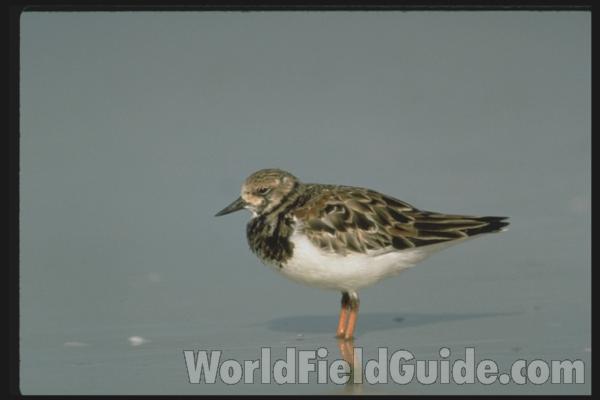SPECIES INFO
Ruddy Turnstone (Arenaria interpres) breeds in the Arctic Regions of both the Old and New World. This circumpolar species winters in southern Eurasia, Africa, Hawaii and many places in the southern United States and the southern Hemisphere. In migration, it is most frequently seen in the United States along the coasts and near the shores of the Great Lakes.
The black and white neck and head evident during the breeding season help identify this bird. During the non-breeding season, the species is brown above and paler below. A short bill and year-round dark breast collar help identify this species. It measures nine inches long.
There are two recognized subspecies. The nominate subspecies is found in Alaska and northern Canada and also northern Eurasia. This winters to Africa and the Australian Region. The subspecies morinella is found in north eastern Alaska and northern Canada wintering to the SE USA and as far south as southern South America.Arenaria plant genus (sandwort) is found widely but primarily in the Northern Hemisphere. There are over 150 species in this genus. These annual or perennial herbs have opposite paired sessile leaves and usually white flowers. There are 23 species and 42 subspecies growing in greater North America.
The genus Arenaria is also used for two species of birds in the shorebird group. These two species are commonly called turnstones.
The turnstones (Arenariinae) generally breed in the northern Hemisphere, but migrate as far south as Australia, Africa, and South America. The following genera are included herein:
Arenaria (2 species)
Sandpipers (Family Scolopacidae) are a group of 82 species of wading and shore birds. Many species in this group run along sandy shores in search of food.
To facilitate study of this family, we will divide it into subfamilies as follows:
Scolopacinae - Woodcocks:
Gallinagininae - Snipes:
Tringinae - Godwits:
Arenariinae - Turnstones:
Galidridinae - Knots, Sandpipers, Stints :
Phalaropodinae - Phalaropes
Shorebirds (Order Charadriformes) are a group of 305 species of worldwide birds. While good fliers, they are much observed feeding along seashores and in the vicinity of inland bodies of water. Seagulls and sandpipers are typical representatives of this order.
There are many different families herein, and most authors end up with about 18 different families. Other groups included herein include the plovers, curlews, coursers, oyster catchers, jacanas, terns, phalaropes, plovers, stilts and avocets, skimmers, snipes, jaegers, and auks and puffins.
Aves contains about 8,650 different species of living birds known to science. Each year about one new species is discovered in some remote rain forest or remote island. In addition, scientists have been raising many subspecies to full species status which may raise the species count to 10,000. Birdlife recognizes 10,027 species as of 2011.
However, each year about one species goes extinct. The rate of extinction is increasing, and the rate of new discovery is decreasing, so that the number of bird species will soon begin to decline rapidly. Although different taxonomists would organize the birds differently, there are approximately twenty-seven orders of birds. These orders are broken down into about one hundred and fifty-five different families.
Recent research of the genetic structure of some of the shore birds and owls would indicate that the present organization of orders and families should have some modification.
The birds are a worldwide group of animals that are characterized by having the front limbs modified into wings that are used for flying. Perhaps the most unique feature of the birds is the feathers. These feathers are made up of a central support called a quill and a series of small filaments that are hooked together as barbs.
For many years it was believed that Archaeopteryx discovered in Bavaria was the oldest bird from about 150 million years ago. However, in l986, Sankar Chattterjee, a Texas paleontologist, reportedly discovered a bird in the genus Protoavis that lived about 225 million years ago.
When this project was begun in 1978, we used Austin & Singer for bird taxonomy. Since then, we have adopted many changes, but have kept some older concepts that are still found widely in the literature. Recently, we have used Clements and Howard & Moore. Very recently, we have used Monroe and Sibley for the higher taxonomy of the perching birds.
Backboned Animals (Phylum Chordata) are the most advanced group of animals on earth. These animals are characterized by having a spinal cord or backbone. Most members have a clearly defined brain that controls the organism through a spinal cord. Fish, amphibians, reptiles, birds, and mammals are in this phylum.
Currently, some taxonomists believe that the fish should be divided into two groups (sharks and regular fishes) and that there are some other primitive groups in the phylum such as hagfish or lampreys.
Animal Kingdom contains numerous organisms that feed on other animals or plants. Included in the animal kingdom are the lower marine invertebrates such as sponges and corals, the jointed legged animals such as insects and spiders, and the backboned animals such as fish, amphibians, reptiles, birds, and mammals.






